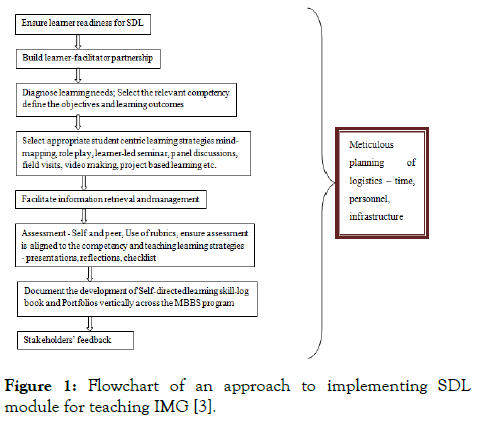Advances in Medical Ethics
Open Access
ISSN: 2385-5495
ISSN: 2385-5495
Short Communication - (2022)Volume 8, Issue 1
The undergraduate medical education scenario in India witnessed a major over haul when Graduate Medical Education Regulation (GMER) was gazetted and Competency Based Medical Education (CBME) implemented in 2019. This curriculum aimed at creating Indian Medical Graduate (IMG) possessing requisite knowledge, skills, attitudes, values and responsiveness, so that he or she may function appropriately and effectively as a doctor of first contact of the community while being globally relevant. (REF) Life- long learner is one of the five identified roles of IMG. To develop the skills of lifelong learner and to ensure active learning, a student centric method of Self- Directed Learning (SDL) was introduced across the MBBS curriculum in the form of 250 hours earmarked for this type of learning. The burning question among the India medical educators is how to plan and deliver an effective SDL session to the students?
Knowles (1975) described SDL as a process wherein the learner initiates it by diagnosing learning needs, formulating goals, identifying the appropriate resources, adapting the correct learning strategy and evaluating the learning outcomes. SDL can be achieved by being competent in competencies such as selfassessment of learning gaps, self and peer evaluation, reflection, information management, critical thinking and critical appraisal as laid down by Patterson in 2002. Staged Self Directed Learning Model (Grow 1991) proposes that learner’s advance through stages of increasing self-direction and that teachers can help or hinder that development. Continuous openness to imbibing changes following experiences, whole person involvement in the learning process including the emotions and the intellect, responsible participation for learning relevant competencies, independence, inquisitiveness, innovativeness and self-reliance are all attributes of a good self-directed learner. SDL skills have been reported to later on improve the performance of physicians and patient care [1].
A step by step approach to SDL session will ensure that both students and teachers achieve the expected outcomes of such sessions. Assessing the readiness of the learners towards SDL using interviews, focus group discussions, validated questionnaires and mixed method studies can be a good first step reported that the readiness of the learners declined significantly with the progress in the professional years across the program. Entry Indian medical students are aged between 17-20 years [2], an age when, most of the learning strategies adopted by them are to ensure completion of the program, rather than acquiring deep knowledge.
Educators thus, have the challenging task of creating a desire and passion amongst the students for acquiring deep knowledge. This could be tackled by using SDL for core competencies, designing sessions which are experiential, immersive and student centric. The age old dictum of assessment drives learning may be used to advantage to ensure deep learning. Using innovative, technology based methods for assessing the deep knowledge may encourage the present generation of digital natives students to avoid rote learning and dwell deeper into the subjects (Figure 1).

Figure 1: Flowchart of an approach to implementing SDL module for teaching IMG [3].
In the current scenario of skewed facilitators to learners’ ratio, embracing technology and the digital tools can assist in meeting the logistic requirements for SDL sessions. Some of the tools that we found useful for the SDL sessions were padlet, mindmap applications, google sheets, google docs, google classrooms and learning management system. These assisted in scaffolding the students’ learning by collating student submissions, grading the progress of the learners and documentation of process. It is prudent to plan in advance SDL sessions including the digital tools, to ensure optimum resource utilisation. Capacity building sessions are an essential way forward in this direction. A similar online session conducted by us on SDL was perceived by teachers as a valuable, educational experience, which they felt will assist them to implement SDL for students. In addition to immense satisfaction derived by the educator in implementing SDL effectively, the educational research opportunities also can motivate the teachers in trying out innovative ways of implementing SDL. Hence, the CBME curriculum and SDL in particular have opened up a gamut of opportunities for both the learners and the facilitators to explore and improvise the field of medical education.
[CrossRef] [Google Scholar] [PubMed]
[CrossRef] [Google Scholar] [PubMed]
Citation: Thalanjeri P, Jain R (2022) Approach to Delivering an Effective Self Directed Learning for Medical Undergraduates: The Indian Scenario. Adv Med Ethics J. 8:005.
Received: 21-Jan-2022, Manuscript No. LDAME-22-15568; Editor assigned: 24-Jan-2022, Pre QC No. LDAME-22-15568(PQ); Reviewed: 04-Feb-2022, QC No. LDAME-22-15494; Revised: 09-Feb-2022, Manuscript No. LDAME-22-15568(R); Published: 16-Feb-2022 , DOI: 10.35248/2385-5495.2022.8.5
Copyright: © 2022 Thalanjeri P, et al. This is an open-access article distributed under the terms of the Creative Commons Attribution License, which permits unrestricted use, distribution, and reproduction in any medium, provided the original author and source are credited.